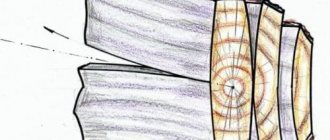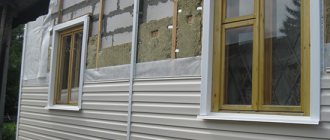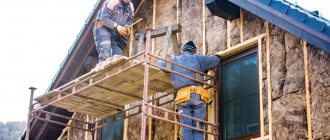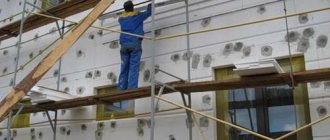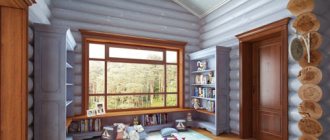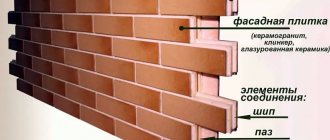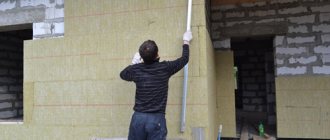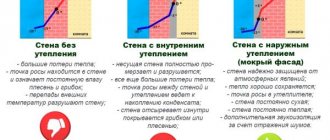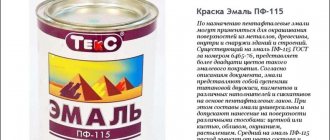SHARE ON SOCIAL NETWORKS
FacebookTwitterOkGoogle+PinterestVk
During the construction of a house, you should consider such a facade, thanks to which the microclimate in the house will be improved, and the supporting frame will be well protected from external forces. If the building is built from easily freezing materials, then insulating the exterior of the house façade is a mandatory task that reduces heating costs, especially in winter. In summer, properly selected insulation will prevent strong heating of the air inside the home.
Insulation of the building facade from the outside helps normalize the microclimate inside the house
Why external insulation and not internal
The most understandable argument for a non-specialist sounds very convincing, although this is a secondary factor - insulation from the inside “takes away” the useful volume of residential and office premises.
Builders are guided by the standard according to which insulation must be external (SP 23-101-2004). Insulation from the inside is not directly prohibited, but it can only be carried out in exceptional cases. For example, when work on the outside cannot be carried out due to the design features or the facade “belongs” to a house that is classified as an architectural monument.
Distinctive characteristics of foam decorative elements
The decor of the facade of a polystyrene foam house has some distinctive characteristics:
- affordable price of products;
- ease and speed of installation of finished products;
- the possibility of decoration without the involvement of specialists;
- minimum weight that does not lead to additional load on the foundation of the building;
- long operational service life;
- excellent water-repellent characteristics;
- increased strength;
- environmental friendliness and resistance to decay processes
Installation work associated with the use of polymer makes it possible to carry out installation in any climatic conditions, regardless of temperature indicators.
Video description
The result of proper internal insulation of a house in the video:
Even such protection from the inside will not provide a 100% guarantee against the wall getting wet - water vapor will find its way into the film joints and fastening points Source domvpavlino.ru
That is, when deciding how to properly insulate a house, in the vast majority of cases, the answer will be based on clear regulatory recommendations - from the outside.
Extruded polystyrene foam
Extrusion is a synthetic insulation material. It is based on a unique technology developed in the USA. The quality of the insulation is so high that many of the best construction companies give it preference in all areas of construction.
Advantages of extruded polystyrene foam:
- Thermal conductivity is extremely low.
- Vapor permeability is insignificant. In comparison, a 20 mm slab has the same level of vapor permeability as 1 layer of roofing felt.
- Resistant to mechanical deforming influences.
- It tolerates a wide temperature range from -50 to +75°C.
- The material is durable, service life is 30 years or more.
- Completely environmentally friendly, does not emit harmful substances during operation.
- When wet, it does not lose its quality characteristics, which is very important in roof insulation.
- Installation is as simple as possible.
There are practically no disadvantages with external and internal insulation. The main factor is flammability, but this can be eliminated by adding fire retardants to the composition, although such boards are somewhat more expensive. In this case, it will only smolder, but the release of harmful substances is still dangerous to health.
But there are exceptions! Insulation from plant materials.
Environmentally friendly insulation made from flax and hemp fibers have unique properties and, using them, you can deviate from generally accepted rules. Thermal insulation made from plant materials does not require the use of vapor barrier. Such thermal insulation can be used both internally and externally in almost any structure. If additional wall insulation is performed, then vapor barrier is not used at all. This is especially important when insulating wooden walls. This method of insulation allows you to maintain a favorable microclimate for a person in a wooden house, while significantly improving the heat-saving characteristics of the structure. If a frame house or roof is insulated with flax insulation or hemp insulation, then instead of a vapor barrier, special vapor barrier cardboard is used. Flax and hemp are natural antiseptics, they are not afraid of moisture and can remove moisture from the structure through their capillary fibers; this is their main difference from other non-organic insulation materials. Linen and hemp insulation are absolutely safe for humans, are not afraid of rodents, are durable and will last more than 70 years.
Features of thermal facade panels
Thermal facade panel consists of a facing layer, behind which the insulation is hidden
Structurally, all types of thermal facade slabs are identical: they consist of two or three layers of facing building material, which hides the insulation from the inside. The front side is usually decoratively finished. The greatest interest from home owners is in panels designed to look like clinker tiles, bricks, and natural stone.
Advantages and disadvantages of application
Thermal facade panels keep you warm in cold weather and cool in the summer heat. The insulating effect of such cladding implies significant savings in energy resources. High thermal insulation properties make it possible to recoup costs within three to four heating seasons.
Another advantage is the low weight of façade thermal insulation panels. They do not exert a significant load on the foundation. Lightweight elements are also easier to install: most products are attached manually without the use of special equipment.
Thermal facade slabs also have other advantages:
- long service life;
- mechanical strength;
- resistance to temperature changes and exposure to sunlight;
- moisture resistance;
- immunity to mold and mildew;
- fire safety;
- environmental friendliness.
The wall surface must be thoroughly prepared before fixing the slabs.
Properties and characteristics
The facade panel can be selected according to three parameters - temperature range, length and width
Cladding panels have the following parameters:
- length – 100–125 cm;
- width – 42–46 cm;
- temperature range - from minus 50 to plus 60 degrees.
The thickness of the products depends on the number of layers and insulation. Wall panels for insulation are durable. According to the manufacturers, they will last for more than fifty years without loss of useful qualities and original shade.
Video description
Which insulation is better? Watch the test of mineral wool, polystyrene and NPE Tepofol in this video:
Tepofol
This is a new type of thermal insulation made of polyethylene foam with a heat-reflecting layer. Made from LDPE - high-density polyethylene. This raw material is widely used in the food industry, which confirms its safety. Surely you have already come across similar material. Previously, it was used in conjunction with other types of thermal insulation only as a vapor barrier. This was due to the production of small thickness - up to 10 mm. The Tepofol company has developed and patented a system of interlocking connections and has the ability to produce insulation up to 150 mm thick. Despite this possibility, in the central region for year-round use, the optimal thickness is 60-80 mm. This allows it to be used as the main thermal insulation without the use of other types of insulation. Tepofol does not absorb moisture and does not lose its properties; it is no longer necessary to use vapor barrier and wind protection. With traditional insulation technology, thermal insulation is laid between the frame. But since the thermal conductivity of wood is higher than that of any thermal insulation, in this case the frame itself will act as a cold bridge. In the case of insulation with Tepofol, the rolls are rolled out along the structure itself, after which the locking joints located on the top and bottom of the roll are soldered together with a construction hairdryer. This allows you to achieve a solid, sealed fabric, without cracks and without cold bridges, without resorting to the use of foam and sealants.
External insulation of the house Source tepofol.ru
Example of internal roof insulation Source tepofol.ru
Expanded polystyrene
Better known as "foam". To be precise, in addition to slabs, this material is also used in granular form as bulk thermal insulation.
Its thermal conductivity varies with density, but on average it is one of the lowest in its class. Thermal insulation properties are provided by a cellular structure filled with air. Its popularity is explained by its availability, ease of installation, good compressive strength, and low water absorption. That is, it is cheap, quite durable (as part of the structure) and is not afraid of water.
Polystyrene foam is considered low-flammable, and those marked PSB-S are self-extinguishing (does not support combustion). But during a fire, it emits toxic gases, and this is one of the main reasons why it cannot be used for insulation from the inside. Its second drawback is low vapor permeability, which imposes restrictions on the use of “breathable” materials when insulating walls.
Extruded polystyrene foam
Insulating the outside of a house with polystyrene foam Source makemone.ru
See also: Catalog of companies that specialize in insulating country houses.
It differs from polystyrene foam by a fundamentally different manufacturing technology, although the raw material is the same polystyrene granules. In some respects it is superior to its “relative”. It has the same percentage of water absorption (no more than 2%), on average, thermal conductivity is 20-30% lower (Table D.1 SP 23-101-2004), vapor permeability is several times lower and compressive strength is higher. Thanks to this set of qualities, it is the best material for insulating the foundation and basement, that is, the walls of the basement and the “zero” floor. The disadvantages of EPS are the same as those of polystyrene foam, and it costs more.
EPPS is usually made “colored” Source footing.ru
Stone, also known as basalt, cotton wool
This is a subtype of mineral wool, the raw materials of which are rocks of stone (most often basalt). A completely different type of thermal insulation material, the low thermal conductivity of which is ensured due to its fibrous structure and low density. It is inferior to foam plastic and EPPS in terms of thermal conductivity (on average 1.5 times higher), but unlike them, it does not burn or smolder (flammability class NG). Refers to “breathable” materials - according to the new standard this sounds like low “breathing resistance”.
Mineral wool mats for wall insulation must be “hard” Source konveyt.ru
But there are other materials for insulating a house outside, which, although used less frequently, have their own advantages.
Features of manufacturing foam decor
There are strict requirements for the polymer that is made for facade finishing of houses. The material for production is PSB 25f. It has all the most important characteristics and qualities in order to be used in exterior wall decoration. Thanks to modern automatic equipment, you can burn and cut contours, create products of different sizes and shapes. In order to achieve reliable protection of the created element from high humidity and sudden temperature changes, sheets of polymer material are coated with a reinforcing compound. For example, you can treat a sheet of polymer material with mineral mixtures created on the basis of acrylic paint.
Next, the sheet is sent for drying. In order for the polymer not to lose its technical and operational characteristics, it is necessary to withstand a certain temperature regime. As soon as the protective layer has dried, the workpiece is sent to the last stage of production: stripping and polishing.
Thermal insulation materials - new products on the market
Additionally, you can always consider new options - they are a little more expensive, but often somewhat more effective than traditional ones.
Foamed polyurethane
A common polymer material for “household use”. Also well known as foam rubber for furniture (in the form of “soft” mats) or as polyurethane foam for sealing cracks. When insulating, it is also used in the form of slabs or sprayed insulation.
Polyurethane foam slabs have low tear-off holding properties, so they are not used in “wet façade” systems.
But this is a common thermal insulation material for making sandwich panels. The same technology underlies the production of thermal panels for facade cladding. Such a panel is a heat-insulating board with a decorative layer (clinker tiles or stone chips) already applied at the factory. Two types of insulation: polystyrene foam and polyurethane foam. In the first case, the thermal panel is two-layer, in the second – three-layer (OSB or moisture-resistant plywood is used as the supporting base). Two mounting options: on dowels/anchors (open method) or on your own hidden fastening system.
Three-layer thermal panel Source zafasad.ru
Sprayed polyurethane foam is in demand if it is necessary to create a seamless layer of thermal insulation on complex surfaces. Until recently, there was only one technology for applying such a layer - using professional installations working with a two-component composition (mixing occurs during spraying).
Spraying polyurethane foam onto the base of a house Source nauka-i-religia.ru
Now in Russia, for household use, the production of one-component polyurethane foam has been launched, which is produced in an aerosol can with a capacity of 1 liter. As the manufacturers assure (there are two competing companies), insulating 1 m2 with your own hands is much cheaper than concluding an agreement with specialized enterprises that use professional equipment. And this option for insulating a house from the outside is quite attractive if literally 2-3 cm of the thermal insulation layer is missing.
Insulation using sprayed polyurethane foam "Teplis" Source m.2gis.kz
Ecowool
Distinctive features of foam decoration
Foam decorations for facades are produced by pouring into special molds.
Attention! When installing foam plastic products on the facade of a house, it is necessary to use a special protective coating. It is necessary to increase the resistance of foam plastic products to external negative influences, increase its strength, and extend its service life.
It is necessary to increase the resistance of foam plastic products to external negative influences, increase its strength, and extend its service life.
There are many reasons why ordinary buyers should purchase decorative elements made of foam plastic.
Manufacturers offer facade decorative elements in a different color range, and at very affordable prices.
Polystyrene foam does not have high reliability, mechanical resistance, or durability, but with the help of modern technologies all these minor shortcomings can be easily eliminated.
Advice! Facade decor made of expanded polystyrene (foam) without additional processing is appropriate only in places that are reliably protected from the effects of the environment.
For example, you can use façade elements made of foam plastic to decorate the cornice, which is located under the roof slope. This area is reliably protected from moisture, and the material is not at risk of mechanical damage.
The facade decor made of polystyrene foam, made in the form of arches, must be treated so that weather conditions do not spoil its appearance. Sometimes decorative elements made of polystyrene foam are used in conjunction with other materials that will allow the decoration to be used for much longer.
Among the recent fashion trends, we note the option of non-standard decoration of the external walls of a private house.
Foam plastic decor for facades is lightweight and easy to process, which is why the material is in demand among architects. It is the decor made of foam plastic that allows the owners of country cottages to turn original design ideas into reality.
The better way to insulate a house from the outside - standards for the number of layers
If you follow the regulatory documents, there are two options for how to insulate a house from the outside in terms of the number of structural and thermal insulation layers: two-layer and three-layer. Moreover, in the second case, the external paneling or plaster is not considered an independent layer, although their thermal insulation properties are taken into account. In three-layer walls, the outer (third) layer is the structural material.
Brick cladding with insulation Source pinterest.ru
In addition to this classification, there is also a division based on the presence of a ventilated and non-ventilated layer.
Total: four recommended types of technical solutions for thermal protection of walls. The standards already indicate insulation options depending on the wall materials and thermal insulation:
- brickwork, reinforced concrete (with flexible connections), expanded clay concrete - all types of solutions;
- wooden houses - enclosing structures with two-layer, three-layer walls and a ventilated air gap;
- frame houses with thin-sheet cladding - three-layer walls with thermal insulation in the middle, as well as with a ventilated and unventilated air gap;
- cellular concrete blocks - two-layer walls with brick cladding, as well as with a ventilated or non-ventilated layer.
In practice, for insulating low-rise buildings, such a variety of solutions comes down to the choice between a “wet” or a curtain wall. Although, it is those recommended by the standard that are considered as thermal insulation materials - mineral wool or expanded polystyrene (EPS as an alternative).
But each case has its own preferences.
Mineral wool
The next option for better insulation of the outside walls of a house is mineral wool. It has a chaotic structure, with fibers of different lengths. It is prepared from basalt material and glass production waste. There is also slag wool. Although the listed varieties differ insignificantly in terms of thermal insulation.
Compared to other insulation materials, it is produced in various forms - mats, rolls, slabs, cylinders, scattered. So, everyone will be able to choose the right option for themselves. Rolled options are most often used, as they eliminate the appearance of cold bridges due to the integrity of the structure. The slabs are convenient for vertical insulation, as they are not subject to deformation. When using an external insulation system in the form of a frame, you can blow out the cells with mineral wool.
The advantage of the material is its non-flammability; it can withstand temperatures up to 1,000 °C, but not every type. Mineral wool acts as a fire-fighting system. When ignited, it does not release toxic substances.
External insulation of wooden houses has its own characteristics, so most materials are simply not suitable for this task. mineral wool is practically the only way to insulate such structures.
Installation is quite simple, even a non-professional can perform it. Thanks to its softness, it fits anywhere and is easily transported without changing shape when bent. Easily cut with a construction knife.
The main and, perhaps, the only drawback is moisture absorption. When performing outdoor work, it is necessary to properly protect the cotton wool from water. Penetration of just 2% water degrades the thermal insulation qualities of the material by 10%.
Another feature is the need for a good installation system. Mineral wool crumbles a lot, so it must be laid under a layer of protection. There should also be moisture drainage below.
The better way to insulate a house from the outside, depending on the wall material
For insulating a brick house, there are no restrictions when choosing technology. Different options can be considered only depending on the chosen method of finishing the facade:
- Facing brick. This is a classic three-layer wall construction with flexible ties. Even when using polystyrene foam, a ventilated air layer is provided to ventilate water vapor and prevent the wall materials from getting wet.
- Wet facade. You can use mineral wool and polystyrene foam. The first option is preferable - ceramic bricks have higher vapor permeability than foam plastic. And according to clause 8.5 of SP 23-101-2004, the arrangement of layers should facilitate the weathering of water vapor to prevent moisture accumulation.
Scheme of a “wet facade” Source deskgram.net
- Ventilated facade. With cladding with wall panels or large-format porcelain tiles on the sheathing. The insulation is traditional for all suspended facades - mineral wool.
Scheme of a ventilated facade Source sk-optimus.com.ua
Wooden houses (logs or beams) are insulated exclusively with mineral wool using curtain facade technology.
For them, you can find examples of using polystyrene foam and plaster using the “wet facade” method. In this case, a ventilated gap is created between the wall and the foam boards using spacer sheathing. Although in this case the main advantage of the “wet facade” is lost - simplicity of design and installation.
Ecowool
The name “ecowool” refers to a crumbly material consisting of cellulose with the addition of flame retardant compounds. Filling the cavities with ecowool provides a continuous thermal insulation layer that penetrates into hard-to-reach cracks and corners. To insulate the facade, both dry and wet-adhesive installation methods are used.
In the first case, a box-shaped structure is mounted on the facade, into which the material is blown dry. In the second, an adhesive composition and a moisturizer are mixed into the material, spraying the resulting mass on the surface using blowing machines, and after drying, it is leveled along the guides with a trimming knife. A layer of ecowool 5 cm in thermal conductivity replaces one-and-a-half brick laying. After the composition has hardened, the insulation can be lined externally using various materials, including siding.
Despite the difficulties in applying ecowool to vertical surfaces, it has its advantages: the ability to be used on any curved and complex shapes and minimal shrinkage during operation.
As you can see, there are many technologies for finishing a façade using insulation, which makes it possible to take into account its original characteristics and the conditions of future operation of the building as much as possible. Properly selected materials and finishing technology contribute to the effective protection of building walls from external influences and optimization of its internal microclimate.
How to calculate the thickness of insulation
If you look through SP23-101-2004 or a similar but later set of rules SP 50.13330.2012, you can see that calculating the thickness of the insulation is not so easy.
Each building is “individual”. When developing a project and approving it, such thermal calculations are made by specialists. And here a whole range of parameters are taken into account - the characteristics of the region (temperatures, length of the heating season, average number of sunny days), the type and area of glazing of the house, the thermal capacity of the floor covering, the thermal insulation of the roof and basement. Even the number of metal connections between the wall and the cladding matters.
But if the owner of a previously built house decides to insulate it (and the new standards introduced in 2003 are much stricter than the old ones), then he will have to choose between three parameters of the “standard thickness” of insulation - 50, 100 and 150 mm. And here the accuracy of calculations is not needed. There is a diagram that shows the equivalent dimensions of the thickness of different materials (in average form), the wall of which will meet the new requirements for thermal protection.
Only a house made of aerated concrete blocks with a thickness of 45 cm does not need insulation Source legkovmeste.ru
And then it’s simple. They take the thickness of a wall made of a certain material and see how much is missing from the standard. And then they calculate in proportion what thickness of the insulation layer of the outside wall of the house should be added. Taking into account that a wet façade also has a layer of plaster, and a ventilated façade has an air gap, plus the interior finishing of the façade walls, you can be sure of sufficient thermal protection.
And the issue of insulating the roof, floors and choosing good windows is decided separately.
It’s even easier to use one of the many online calculators. The figure here, of course, is approximate, but rounded up to the nearest standard insulation thickness, it will give the required result.
Question answer
Are all insulation materials equally effective?
The thermal conductivity coefficient of insulation does not differ much, so it is usually customary to talk about the average thickness of the insulation. The main thing is that the choice of insulation is based on the degree of humidity, which directly affects the characteristics of the insulation.
Is durability an important factor when choosing insulation?
Yes, sure. Because it is necessary to understand that the longer the service life of the insulation, the longer the effect of its use will last.
How to insulate the facade of a house, roof, floors more easily
The easiest way, according to the rules, is to insulate the facade with polystyrene foam, then plaster it, or use mineral wool as insulation and decorate the walls with siding or panels.
How to decide on thickness
When choosing the thickness of insulation for external walls, it is necessary to rely on the appropriate thickness that provides the greatest benefit for heating. You can calculate it using the formula, or use an online calculator.
Internal insulation compensates for the lack of external
Internal insulation is less preferable than external insulation, since the dew point shifts. It is worth insulating inside only if external insulation is impossible, adhering to certain parameters.
How to properly install insulation on a facade
Before installation, the facade must be prepared: cleaned of old finishes, removed dirt and dust, dismantled hanging elements of engineering systems, removed ebbs and canopies (you will still have to replace them with wider ones), remove signs, plates and façade lamps. Then the surface of the wall must be strengthened - cracks and chips must be repaired, crumbling areas must be cleaned, and a deep penetration primer must be applied.
Application of primer composition Source rmnt.ru
For reliable fastening of polystyrene foam or rigid mineral wool mats in a wet façade system, the wall surface must be as smooth as the unevenness can be smoothed out with an adhesive solution. If the height difference is up to 5 mm, the solution is applied over the entire insulation slab, with unevenness from 5 to 20 mm - along the perimeter and in the form of “cakes” on 40% of the slab surface.
The first row of slabs is mounted with emphasis on the starting bar, which also sets the horizontal level. The second and subsequent rows are placed with a vertical seam shift (at least 200 mm), leveling the surface of the insulation in the area of the joints so that the height difference is no more than 3 mm. When insulating the walls around the openings, make sure that the seams of the slabs do not intersect in their corners. Each slab is additionally secured with umbrella dowels at the rate of 5 pcs. per 1 m2.
Before applying plaster, the surface of the slabs is reinforced with fiberglass, fixed in the middle of a layer of adhesive solution with a total thickness of 5-6 mm.
The density of polystyrene foam is chosen to be 25-35 kg/m3.
Nuances when installing façade foam plastic
Any construction process has its own nuances that must be observed. There are also special features for insulating the façade with polystyrene foam.
For example, if communications have not yet been connected to the house, before installing the insulation, it is necessary to mark their places with pipes or something else, so that when attaching the foam plastic, the dowel is not driven into the void or too close to the edge.
When working with polystyrene foam, it is worth remembering that all seams must be treated with polyurethane foam to prevent them from turning into cold bridges and moisture from getting inside. This is done even if the sheets were tightly fitted to each other.
Additional fixation of foam plastic with dowels is a necessary step when insulating, but when choosing fastening material it is important not to make a mistake. So, the length of the fastenings should be such that they have the opportunity to penetrate through the insulation layer and linger in the facade
For example, brick walls require a dowel length 9 cm longer than the foam layer, and concrete walls - 5 cm. The situation is most difficult with porous building materials, since it is quite difficult to bury fasteners in them. For this option, fungi are suitable, which can penetrate 12 cm into the base.
To avoid damage to the foam sheet, the dowels are not driven too deeply into the insulation. The optimal depth is 1 cm. To prevent the slab from cracking, the dowels are driven 20 cm from the edge.
To reliably strengthen a sheet of foam plastic, 5–6 pieces of fasteners are needed, and they should be located at approximately the same distance from each other. The glue on the back side should occupy approximately 50% of the total sheet area.
The main thing after insulating the facade is not to leave the foam for a long time without finishing cladding. Although this material is highly resistant to external influences, it can quickly become unusable from ultraviolet rays.
Video description
Visually about mineral wool insulation in the video:
Attention. In the “wet facade” system, the insulation is installed in only one (!) layer. A vertical surface made of two layers of “soft” slabs loaded with plaster behaves unpredictably, especially with changes in temperature and humidity conditions. Do not be fooled by arguments that the second layer of slabs overlaps the seams of the first and eliminates “cold bridges”.
The ventilated facade uses rigid mineral wool mats with a density of 80 kg/m3. If the surface of the mats is not laminated, then after attaching them to the sheathing, the surface is covered with either fiberglass or a vapor-permeable membrane.
The spacing of the lathing is chosen 2-3 cm less than the width of the mats. In addition to fastening to the sheathing, the insulation is additionally fixed to the wall with umbrella dowels.
The size of the air gap between the insulation and the cladding should be in the range of 60-150 mm.
Important. The size of 40 mm is standardized for non-ventilated air spaces.
To ventilate the layer in the cladding, inlet openings are installed in the base area and outlet openings are installed under the roof eaves. The total area of the holes must be at least 75 cm2 per 20 m2 of wall.
Ventilation grilles in the wall Source tproekt.com
Protection of the facade from wind and moisture
Some special mineral wool boards, according to manufacturing companies, can be covered with cladding without creating an additional barrier from wind and moisture. These materials have a hard outer layer (such as Venti Butts D Optima) or are covered with fiberglass (GEO). They should be used in structures with a metal frame, to which it is problematic to attach additional wind-waterproofing layers.
DuPontIf strips of wind and waterproofing material are mounted vertically, their joints should be taped with special tape.
DuPont
When finishing openings, it is necessary to carefully seal the seams between the slope panels, otherwise moisture will enter the structure and the insulation under the window will become damp.
However, the vast majority of slab insulation requires protection from weathering and moisture. Vapor-permeable membranes serve this purpose - Tyvek and AirGuard (DuPont), AQproff and AF+ (Izospan), etc. They are mounted in horizontal stripes from the bottom up with an overlap of at least 10 cm, first fixed with a construction stapler, and then pressed with counter-lattice slats.
If there are open seams between the cladding elements (as in the case of wooden planks), you also need to purchase light-resistant wind protection, for example UV Fasade (DuPont), DELTA-FASSADE and DELTA-FASSADE S (Dörken).
DuPontIf there are open seams between the cladding elements (as in the case of wooden planks), you need to purchase a dark, light-resistant wind protection, for example UV Fasade (DuPont) or DELTA-FASSADE (Dörken).
DuPont
Dew point shift diagram
There are several options for placing insulation relative to the wall: inside, outside, between walls. The main thing to start from is the dew point. Let's look at all the options.
The dew point is the temperature at which water vapor in the air reaches saturation and begins to condense. The dew point at 100% air humidity and the actual air temperature are the same.
Based on current trends, insulating the exterior of a house’s facade is an excellent option for preserving heat. In this case, the dew point falls on the insulation, which means there will be dry walls inside. Otherwise, the outside of the wall will freeze, and the internal areas will become wet and moldy. This process is shown more clearly in the figure.
Portfolio
Cladding of a building using the example of the Khovrinskaya illegal armed group
Our company has installed an NVF at the Khovrinskaya pumping station with a total area of 2,200 m2.
Porcelain tile facade of the Tikhoretsky shopping center
Facade area – 855 m2
Work completion time: 60 calendar days
Ventilated facade of the school “Integration XXI Century”
Facade area – 700 m2
Work completion time: 50 calendar days
Reviews about different types of insulation
The rating of insulation for wooden houses is headed by TechnoNIKOL Rocklight basalt house insulation. Users note the ease of installation and a wide range of operating temperatures. Plus, this insulation is recognized by users as the best safe insulation.
Penoplex Comfort is recognized as the best insulation for walls and floors. Users note the possibility of self-installation of this material, as well as its good thermal insulation characteristics.
Users choose Bronya Nord as liquid thermal insulation for its durability, low consumption and low cost.
